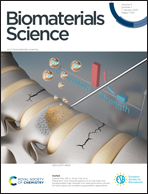NO released via both a Cu-MOF-based donor and surface-catalyzed generation enhances anticoagulation and antibacterial surface effects
Abstract
The anticoagulation and antibacterial functions of implant and interventional catheters during indwelling will determine their success or failure. Here, an amino-containing copper-based metal–organic framework (Cu-MOF) coating was prepared on the thermoplastic polyurethane substrate (TPU) surface by spin coating for anti-thrombotic and anti-infection effects. The adhesion properties of the polyurethane prepolymer coating (PC) enhanced the binding force of Cu-MOF particles and TPU surface and improved stability. Due to the coordination affinity of Cu2+ with nitric oxide (NO) and the NO loading capacity of the amino group, it showed that a large amount of NO was loaded in the coating. Meanwhile, the coordinated Cu2+ in the coating also catalyzed endogenous NO donors to generate NO, which prolonged the NO release for up to 30 days. The results of antibacterial experiments showed that the NO released from the coating had good antibacterial effects on both E. coli and S. epidermidis. An obvious antibacterial ring can be seen and the antibacterial rate was higher than 96%. It also showed inhibiting platelet adhesion and activation, prolonged in vitro clotting time and inhibited thrombus formation. In summary, for the first time, NO release from the coating was realized by the combined ways of NO donor and catalytic endogenous NO donor. It can not only meet the high NO release rate required for early anticoagulation and antibacterial of the catheter but also maintain normal anticoagulation requirements in the later period.



 Please wait while we load your content...
Please wait while we load your content...